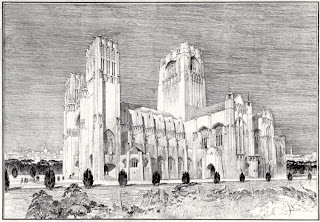Image may be NSFW.
Clik here to view.
Image may be NSFW.
Clik here to view.
Charles Rennie Mackintosh (1868-1928), the virtual inventor of Glasgow Art Nouveau, is principally known for his domestic architecture and furnishing. He nonetheless made several forays into public building (for instance, the innovative Glasgow Art School, with its stripped semi-Gothic mien and acreage of glass, and a number of other structures) and a single built church, the hulking Presbyterian Queens' Cross Church (1898-1899). He had earlier won a medal for the design of a hypothetical Chapter House in 1891. It is a handsome if rather heavy structure, suggesting one of the many roads not taken at the turn of the last century and mingling Mackintosh's own signature style with the less self-consciously manneristic Gothic revival of the period. The interior has a handsome simplicity, white-walled and trimmed with grey stone, the Gothic woodwork stylized in interestingly idiosyncratic ways.
Image may be NSFW.
Clik here to view.
Image may be NSFW.
Clik here to view.
Mackintosh's other principal foray into ecclesiastical design remains unbuilt. It was a competition entry for Liverpool Anglican Cathedral, in the same competition won by Giles Gilbert Scott's magnificently muscular design. Mackintosh's own drawings are masterworks of stylized Arts and Crafts detailing applied to a more conventional Gothic framework, and are an interesting inversion of Gilbert Scott's own proposal, which, both in its initial design and final built form yokes unusual, emotional massing and layout with more straightforwardly Gothic ornamentation. While we are grateful it was Scott who won the competition, this should not lessen our admiration for Mackintosh's fleeting forays into Gothic revivalism, which remain intriguing case studies. (Image Sources: Wikipedia, Unbuilt Mackintosh; more examples of the Liverpool project drawings can be seen here).
Image may be NSFW.
Clik here to view. Image may be NSFW.
Image may be NSFW.
Clik here to view.
Clik here to view.

Image may be NSFW.
Clik here to view.

Charles Rennie Mackintosh (1868-1928), the virtual inventor of Glasgow Art Nouveau, is principally known for his domestic architecture and furnishing. He nonetheless made several forays into public building (for instance, the innovative Glasgow Art School, with its stripped semi-Gothic mien and acreage of glass, and a number of other structures) and a single built church, the hulking Presbyterian Queens' Cross Church (1898-1899). He had earlier won a medal for the design of a hypothetical Chapter House in 1891. It is a handsome if rather heavy structure, suggesting one of the many roads not taken at the turn of the last century and mingling Mackintosh's own signature style with the less self-consciously manneristic Gothic revival of the period. The interior has a handsome simplicity, white-walled and trimmed with grey stone, the Gothic woodwork stylized in interestingly idiosyncratic ways.
Image may be NSFW.
Clik here to view.

Image may be NSFW.
Clik here to view.

Mackintosh's other principal foray into ecclesiastical design remains unbuilt. It was a competition entry for Liverpool Anglican Cathedral, in the same competition won by Giles Gilbert Scott's magnificently muscular design. Mackintosh's own drawings are masterworks of stylized Arts and Crafts detailing applied to a more conventional Gothic framework, and are an interesting inversion of Gilbert Scott's own proposal, which, both in its initial design and final built form yokes unusual, emotional massing and layout with more straightforwardly Gothic ornamentation. While we are grateful it was Scott who won the competition, this should not lessen our admiration for Mackintosh's fleeting forays into Gothic revivalism, which remain intriguing case studies. (Image Sources: Wikipedia, Unbuilt Mackintosh; more examples of the Liverpool project drawings can be seen here).
Image may be NSFW.
Clik here to view.
 Image may be NSFW.
Image may be NSFW.Clik here to view.

